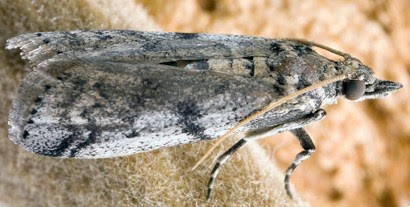Navel Orangeworm SIR
Navel Orangeworm (Amyelois transitella)
Navel Orangeworm (USA)
Navel Orangeworm (Amyelois transitella) (NOW) presents considerable risk to the pistachio industry, both in yield reduction and public perception. Wild populations of NOW may have three to four generations depending on field sanitary practices (Agriculture and Natural Resources, University of California. 2014a), and present a risk to tree nuts during their larval phase of life. Female NOW lay their eggs on “mummy” nuts in the trees or on new crop nuts after the initiation of hullsplit (Agriculture and Natural Resources, University of California 2014b). After egg hatch, the larvae eat the fruit of the nut, causing damage and creating litter within the shell. Economically, the impact threshold for pest damage to the pistachio industry is 0.5% (DuPont acc. 2015) and it is not uncommon for growers to find infestations on average of 2% (Kallsen 2002). At infestation levels of 5% or greater, growers will likely be forced to relegate the “entire load of nuts to be processed as shelling stock or lesser products instead of being packaged as the more valuable in-shell nuts that consumers associate with pistachios” (Kallsen 2002). NOW is the primary pest of almonds and pistachios with damage approaching 30% in both crops if left unchecked (Higbee and Siegel. 2009). In addition to economic impact, public perception may also be negatively impacted, as frass and other detritus associated with larval infestation may remain in shell nuts and in some cases NOW may hatch within bags shipped to consumers. Finally, secondary fungal infections as a result of larval damage can result in the development of dangerous aflotoxins, which present a risk to human health.
The pistachio industry has seen significant growth over the past decade and NOW presents a considerable risk to the success of the industry if left unchecked.


During the winter of 2014, pistachio growers approached USDA-APHIS to develop a program to eradicate this economically destructive pest from pistachio growing regions throughout California. As a result, the Pink Bollworm Rearing Facility located in Phoenix, AZ developed methods and techniques to mass rear NOW with the goal of providing sterile moths to the field as a SIT component of an AW-IPM Program to aid in the eradication of NOW. IPM is an ecologically friendly method to achieve insect population suppression and (potentially) eradication by using a multifaceted approach to pest management. IPM focuses on achieving biological, cultural and mechanical control with limited chemical applications to achieve the desired level of suppression or eradication of a pest. The use of SIT as an AW-IPM component is well documented (Dyck 2005) and has proven successful in USDA-APHIS eradication programs, such as new world screwworm, pink bollworm and suppression programs such as medfly have validated the use of SIT as a population suppression and eradication technique within the context of an AW-IPM program.
Tools to combat this pest are limited because of difficulties in obtaining good coverage with pesticides at key periods prior to harvest when splitting nuts are especially vulnerable to NOW attack. There is also evidence that pesticide resistance is increasing and developing new materials is time consuming, leaving growers to wait for viable chemicals. The principle goals of the development of SIT for NOW were to develop and adapt existing equipment and infrastructure for rearing PBW to mass-rear NOW. An important aspect following the development of these lab methods is to have a reliable release regime. Here - as noted above - the development of UAS for lepidopteran SIT presents the NOW program with the ability to release highly competitive insects via UAS as opposed to relying on other methods which may be less effective (e.g. ground) or more costly (e.g. manned aircraft) than the deployment of UAS.